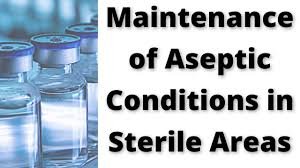Maintenance of Aseptic Conditions in Pharmaceutical Sterile Areas

Maintenance of Aseptic Conditions in Pharmaceutical Sterile Areas
1. Introduction
Sterile areas in pharmaceutical manufacturing (e.g., aseptic filling, compounding, cleanrooms, isolators) require strict control to prevent contamination. Maintaining aseptic conditions is critical for patient safety, product quality, and regulatory compliance (GMP/WHO/USFDA/EMA).
2. Key Practices for Maintaining Asepsis
a. Facility & Equipment Design
-
Classified cleanrooms with HEPA-filtered unidirectional airflow.
-
Airlocks for personnel and materials.
-
Differential pressure between cleanroom grades to ensure airflow from clean → less clean areas.
-
Use of smooth, non-shedding, easy-to-clean surfaces.
-
Regular HEPA filter integrity testing and HVAC validation.
b. Personnel Control
-
Strict gowning procedures (sterile coveralls, gloves, masks, goggles).
-
Aseptic training and qualification (media fill test, gowning qualification).
-
Restricted entry (only trained and authorized staff).
-
Continuous monitoring of operator aseptic practices.
c. Cleaning & Disinfection
-
Use of validated disinfectants (sporicides, alcohols, quaternary ammonium, peroxides).
-
Rotation of disinfectants to prevent resistance.
-
Scheduled cleaning of floors, walls, equipment, and pass boxes.
-
Use of sterile wipes and mops in critical areas.
d. Environmental Monitoring (EM)
-
Non-viable monitoring (particle counters).
-
Viable monitoring (settle plates, contact plates, active air samplers, glove prints).
-
Trend analysis of EM data to detect deviations early.
-
Alert and action limits defined as per GMP Annex 1 / ISO 14644.
e. Material & Equipment Transfer
-
Use of pass boxes (static/dynamic) with interlocks.
-
Sanitization of incoming materials with sterile wipes/disinfectants.
-
Use of sterile wrapping for critical components.
f. Process Controls
-
Validated aseptic techniques (no-touch techniques, proper laminar airflow practices).
-
Regular media fill validation of aseptic processes.
-
Proper maintenance of unidirectional airflow workstations (LAF/isolators).
-
Immediate corrective actions for any deviation.
g. Preventive Maintenance & Qualification
-
Scheduled calibration and maintenance of cleanroom equipment.
-
HVAC requalification and HEPA filter leak testing.
-
Routine autoclave/sterilizer validation.
3. Documentation
-
SOPs for gowning, cleaning, monitoring, equipment use.
-
EM records, deviation/CAPA reports.
-
Training records and requalification schedules.
✅ In short:
Maintenance of aseptic conditions in sterile pharmaceutical areas depends on cleanroom design, trained personnel, validated cleaning/disinfection, environmental monitoring, controlled material transfer, and strict documentation.
🎓 Discover one of the best Pharmaceutical Microbiology course available —click below to explore the course that’s shaping future Microbiology course skills.

